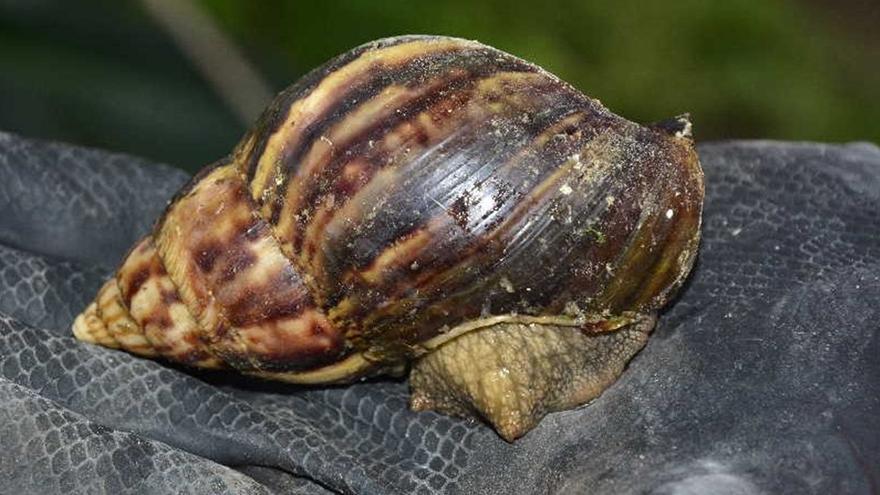
![]() 14ymedio, Mercedes García, Havana, 21 December 2023 — Although the issue has ceased to appear in the official press, the presence of the giant African snail continues to spread through Cuba, and the economic crisis makes it almost impossible to combat it, due to the lack of resources and fuel. In Sancti Spíritus, the plague wreaks havoc on agriculture and homes, according to sources from the Plant Health Research Institute (INISAV).
14ymedio, Mercedes García, Havana, 21 December 2023 — Although the issue has ceased to appear in the official press, the presence of the giant African snail continues to spread through Cuba, and the economic crisis makes it almost impossible to combat it, due to the lack of resources and fuel. In Sancti Spíritus, the plague wreaks havoc on agriculture and homes, according to sources from the Plant Health Research Institute (INISAV).
“Many people have forgotten about this animal, but we receive reports every day,” an INSAV employee in the province, who prefers anonymity, explains to 14ymedio. In Sancti Spíritus, the municipalities most affected by this species, considered one of the hundred most invasive in the world, are Cabaiguán, Taguasco and the provincial capital.
“We received a complaint that they saw the snails in one place, but we can’t do anything because we don’t have the resources. We’re not even going to check the level of infestation because we don’t have the necessary fuel to move within the province,” the worker emphasizes.
“Right now we are focusing on the School of Medicine, in the former Faculty of Nursing, which has a vacant lot between the houses and the buildings. That area is infested with snails,” he explains. “Specimens have even been found in the lime ovens on the outskirts of the city. They are everywhere, and nothing stops them.”
“We received the complaint that they saw the snails in one place, but we can’t do anything because we don’t have the resources; we’re not even going to check the level of infestation”
The expert sees a relationship between the flooding of the stream that borders the city of Sancti Spíritus and the spread of the plague. “If the water rises, the snails spread everywhere, so what seems like good news for agriculture, that there is water to plant, becomes a headache with this animal in here.”
In the municipality of Taguasco, the main focus is on the crops of the Agroforestry Company. “There they have eaten everything. It makes you want to cry because we are having a bad time with crop productivity, and on top of that this plague arrives to devour them.”
In Cabaiguán, on the other hand, it is the neighbors who suffer the ravages of the giant African snail in their own courtyards. “You can’t leave anything outside because you get up and some of them have already been eaten,” laments Cipriano, 81 years old and a resident of the town. “We had everything very beautiful, with flowers and everything, but since that bug arrived we don’t even have hibiscus.”
“We used to throw salt on them, but we no longer can afford the expense,” the farmer admits. “Now, if you come across one, you try to crush it or chop it with a machete, but for each one you see there are many more. We can’t be awake all morning waiting for them to come out.”
“They haven’t reported anything for a long time as if they had disappeared, but we continue to suffer from them,” Cipriano complains. “We don’t see anything on television; we don’t hear anything on the radio, but you just have to leave the house to see them everywhere. Right now they are big enough to carry us.”
“They haven’t reported anything for a long time as if they had disappeared, but we continue to suffer from them”
In 2019, when the presence of the snail was already confirmed in 12 provinces, the Plant Health Research Institute issued guidelines for the population to contribute to the control and elimination of the giant African snail, but the arrival of the COVID-19 pandemic, the economic crisis, the lack of fuel and inflation shifted the focus of interest to other issues of daily life.
Among the measures that INSAV suggested then was the destruction of the snail and its subsequent burial in a hermetically sealed bag. Another option was to burn it safely or immerse it in a 3% solution of salt or lime (three tablespoons 4.2 cups of water) for 24 hours and then bury it. In no case should the snails be thrown alive into rivers, plots, streets or garbage dumps.
The giant African snail can transmit diseases to crops in addition to consuming at least 250 types of plants, many of them planted for economic purposes. It also causes irreparable damage to the ecosystems it colonizes. It has a great ability to adapt to the climate and to all types of terrain. In Cuba it does not have natural predators that can put a stop to its insatiable appetite.
The first information about the arrival of this mollusc on the Island was released by this newspaper in July 2014 after a tour of the Havana municipality of Arroyo Naranjo. The text warned that “this species will test the capacity of the national public health system in Cuba to control this type of situation.” That forecast seems to have fallen short.
Translated by Regina Anavy
____________
COLLABORATE WITH OUR WORK: The 14ymedio team is committed to practicing serious journalism that reflects Cuba’s reality in all its depth. Thank you for joining us on this long journey. We invite you to continue supporting us by becoming a member of 14ymedio now. Together we can continue transforming journalism in Cuba.
